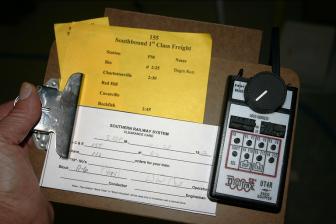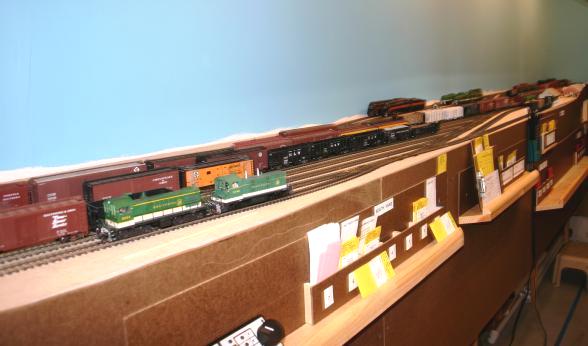Building a model railroad for realistic operations
Much has been written about designing and building a model railroad that represents realistic operations of a prototype, including several recent articles in Model Railroader. And Iíve seen many great layouts that presented a realistic scene and some that even realistically represented the operation of the prototype. But a recent experience really brought home the benefits of this process, and I would like to share my experience.Several months ago, members of the Norfolk and Western Historical Society and the Southern Railway Historical Association gathered in Lynchburg, Va. for a day of modeling activity (I know, Virginia is not in the SER, but the editor said it would be alright if I talked about something relevant, even though it was not on SERís turf.) This was the first time these two organizations have collaborated on an event like this. Hopefully they will do it again, as many of us belong to both groups.
While main program was a day of interesting clinics, an added feature was an opportunity to visit Bill Coxís Virginia Blue Ridge and Southern layout on Friday night, and for a fortunate few, an opportunity to participate in an operating session on Saturday night. I was one of those fortunate enough to be invited to stay and play.
 Bill Cox has created a splendid HO-scale model railroad that fills a 24
by 36 foot building behind his home. When I asked about the design, he
said that he started with an idea for operating sessions, then designed
a layout that would accommodate this idea, and finally designed and
built a building to a house the layout. What a radical idea! I usually
get it backwards: I start with a space, design a layout that fits, using
proven design criteria, and then try to operate something that approaches
the prototype. I have to admit, his idea is a lot better.
Bill Cox has created a splendid HO-scale model railroad that fills a 24
by 36 foot building behind his home. When I asked about the design, he
said that he started with an idea for operating sessions, then designed
a layout that would accommodate this idea, and finally designed and
built a building to a house the layout. What a radical idea! I usually
get it backwards: I start with a space, design a layout that fits, using
proven design criteria, and then try to operate something that approaches
the prototype. I have to admit, his idea is a lot better. Cox has taken about a 50-mile stretch of the Southern Railroad that ran near his home in Lynchburg and replicated it in HO scale. He has a double track mainline with appropriate sidings, branch lines, and similar features that were, for the most part, really there. The center point of the layout is the yard at Monroe, Virginia, just north of Lynchburg. One end of his mainline terminates near Charlottesville, and the other end ends near Roanoke. Neither of these distant points is actually shown on the layout - the line ends just short of these cities. In reality, the tracks are continuous and disappear into a holding yard at each end where trains are turned and stored on hidden reverse loops until needed again. There are interchange points for both N&W and C&O, just as they really existed. The basis for all of this trackage is quite authentic and much of it is still in service. If you have a current Railroad Atlas or NS route map, you can find this trackage in NSís Virginia Division.
As we have already noted, even though Charlottesville and Roanoke are well-known railroad cities, they donít exist here. The focal point of the action on Billís layout is the yard at Monroe, Virginia. Bill told me that as a boy he used to go watch the trains at Monroe and was fascinated with what he saw. Now, fifty years later, he can recreate that scene. Just as it was fifty years ago, freight trains pass through, most with cars that have to be set off or picked up. Likewise there are passenger trains that stop for passengers, Sometimes a car, such as a dinner, must be added, or taken out of a train. And on some trains, Southern diesels are swapped for a Norfolk and Western J-class steam engine (or vice versa). All of this keeps a yard master, a hostler and a switch-engine crew quite busy.
The scene is set.
It is July 19, 1956. This session ran on a four-to-one fast clock. Bill set the clocks for 0540. (It was actually about 7:00 p.m.) Our first train was due out at about 0600, so we had about five minutes to get our assignments, get a Digitrax throttle, find our trains, and get ready for the dayís operation. Bill served as the dispatcher, keeping us pretty much on time for the three hours that followed.
I started the session working as an engineer on the switch engines in the yard at Monroe, shown below. Fortunately our Yardmaster, Steve Robbins, is an old hand at this, and got us off to an early start sorting cars to make work easier later on. It was a good thing that he did, for indeed, the yard became a buy place. Steve has an advantage over several of us: He worked for SP, MP and UP.

